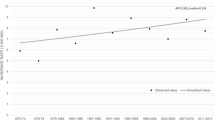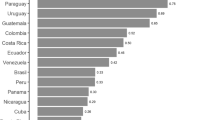Abstract
Objective: We examined the relationship between race/ethnicity and testis cancer survival in a population-based setting.
Methods: We analyzed 16,086 cases of primary testis cancer diagnosed during 1973–1999 and reported to 12 cancer registries participating in the National Cancer Institute's Surveillance, Epidemiology, and End Results Program. We compared testis cancer-specific survival between patients from different racial/ethnic groups by use of the hazard ratio (HR) and 95% confidence intervals (CI) calculated from Cox proportional hazards models, adjusting for stage, histology, and period of diagnosis.
Conclusion: These findings are consistent with previous reports of race/ethnic disparities in stage at diagnosis and survival in testis cancer patients as well as other cancer patients. Further research is needed to understand the reasons underlying these disparities.
Similar content being viewed by others
References
Clegg LX, Li FP, Hankey BF, Chu K, Edwards BK (2002) Cancer survival among US whites and minorities: a SEER (Surveillance, Epidemiology, and End Results) Program population-based study. Arch Intern Med 162: 1985–1993.
Li CI, Malone KE, Daling JR (2003) Differences in breast cancer stage, treatment, and survival by race and ethnicity. Arch Intern Med 163: 49–56.
Gilliland FD, Hunt WC, Key CR (1998) Trends in the survival of American Indian, Hispanic, and Non-Hispanic white cancer patients in New Mexico and Arizona, 1969-1994. Cancer 82: 1769-1783.
Stanford JL, Stephenson RA, Coyle LM, et al.(1999) Prostate Cancer Trends 1973-1995. Bethesda, MD: SEER Program, National Cancer Institute.
Ries LAG, Eisner MP, Kosary CL, et al., eds. (2003) SEER Cancer Statistics Review, 1975-2000. Bethesda, MD: National Cancer Institute.
Lin SS, Clarke CA, Prehn AW, Glaser SL, West DW, O'Malley CD (2002) Survival differences among Asian subpopulations in the United States after prostate, colorectal, breast, and cervical carcinomas. Cancer 94: 1175–1182.
Brown LM, Pottern LM, Hoover RN, Devesa SS, Aselton P, Flannery JT (1986) Testicular cancer in the United States: trends in incidence and mortality. Int J Epidemiol 15: 164–170.
Bergstrom R, Adami HO, Mohner M, {et al}(1996) Increase in testicular cancer incidence in six European countries: a birth cohort phenomenon. J Natl Cancer Inst 88: 727–733.
Einhorn LH (2002) Curing metastatic testicular cancer. Proc Natl Acad Sci U S A 99: 4592–4595.
Surveillance, Epidemiology, and End Results (SEER) Program (www.seer.cancer.gov) Public-Use Data (1973-2000) National Cancer Institute, DCCPS, Surveillance Research Program, Cancer Statistics Branch; released April 2003, based on the November 2002 submission.
Clark TG, Altman DG, De Stavola BL (2002) Quantification of the completeness of follow-up. Lancet 359: 1309–1310.
Schoenfeld D (1980) Chi-squared goodness-of-fit tests for the proportional hazards model. Biometrika 69: 239–241.
Bradburn MJ, Clark TG, Love SB, Altman DG (2003) Survival analysis Part III: multivariate data analysis-choosing a model and assessing its adequacy and fit. Br J Cancer 89: 605–611.
Frost F, Taylor V, Fries E (1992) Racial misclassification of Native Americans in a surveillance, epidemiology, and end results cancer registry. J Natl Cancer Inst 84: 957–962.
Stewart SL, Swallen KC, Glaser SL, Horn-Ross PL, West DW (1998) Adjustment of cancer incidence rates for ethnic misclassi-fication. Biometrics 54: 774–781.
Sugarman JR, Dennis LK, White E (1994) Cancer survival among American Indians in western Washington State (United States). Cancer Causes Control 5: 440–448.
O'Malley CD, Le GM, Glaser SL, Shema SJ, West DW (2003) Socioeconomic status and breast carcinoma survival in four racial/ethnic groups: a population-based study. Cancer 97: 1303–1311.
Barnholtz-Sloan JS, Tainsky MA, Abrams J, {et al}(2002) Ethnic differences in survival among women with ovarian carcinoma. Cancer 94: 1886–1893.
Hashibe M, Gao T, Li G, Dalbagni G, Zhang ZF (2003) Comparison of bladder cancer survival among Japanese, Chinese, Filipino, Hawaiian and Caucasian populations in the United States. Asian Pac J Cancer Prev 4: 267–273.
Pagano IS, Morita SY, Dhakal S, Hundahl SA, Maskarinec G (2003) Time dependent ethnic convergence in colorectal cancer survival in Hawaii. BMC Cancer 3: 5
Meng L, Maskarinec G, Wilkens L (1997) Ethnic differences and factors related to breast cancer survival in Hawaii. Int J Epidemiol 26: 1151–1158.
Author information
Authors and Affiliations
Corresponding author
Rights and permissions
About this article
Cite this article
Lou Biggs, M., Schwartz, S.M. Differences in Testis Cancer Survival by Race and Ethnicity: A Population-Based Study, 1973–1999 (United States). Cancer Causes Control 15, 437–444 (2004). https://doi.org/10.1023/B:CACO.0000036443.95995.40
Issue Date:
DOI: https://doi.org/10.1023/B:CACO.0000036443.95995.40




